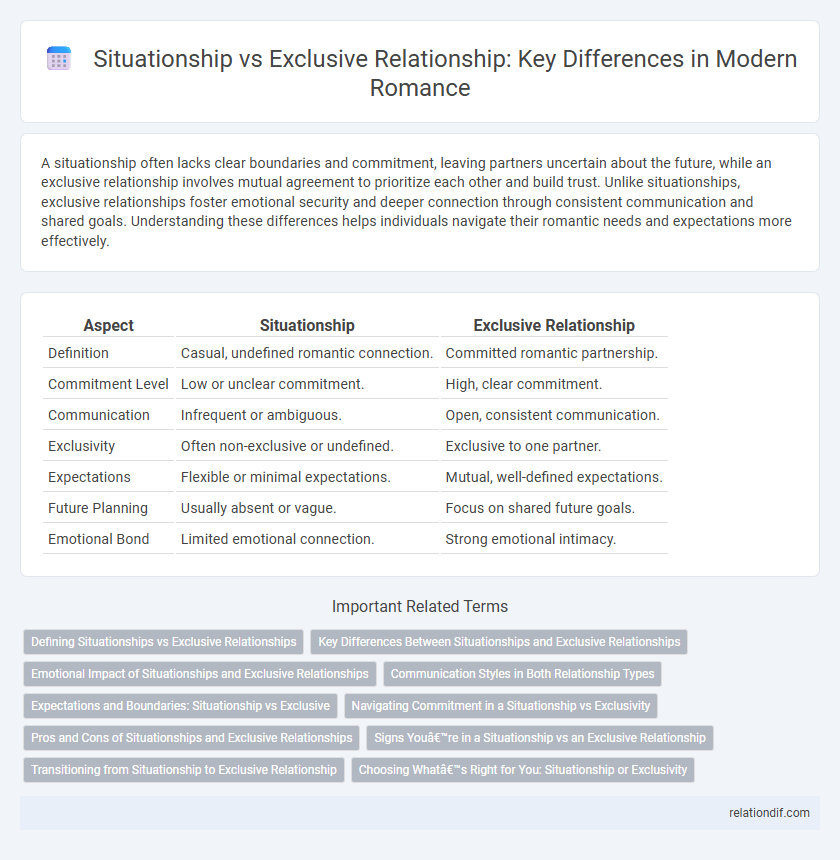A situationship often lacks clear boundaries and commitment, leaving partners uncertain about the future, while an exclusive relationship involves mutual agreement to prioritize each other and build trust. Unlike situationships, exclusive relationships foster emotional security and deeper connection through consistent communication and shared goals. Understanding these differences helps individuals navigate their romantic needs and expectations more effectively.
Table of Comparison
| Aspect | Situationship | Exclusive Relationship |
|---|---|---|
| Definition | Casual, undefined romantic connection. | Committed romantic partnership. |
| Commitment Level | Low or unclear commitment. | High, clear commitment. |
| Communication | Infrequent or ambiguous. | Open, consistent communication. |
| Exclusivity | Often non-exclusive or undefined. | Exclusive to one partner. |
| Expectations | Flexible or minimal expectations. | Mutual, well-defined expectations. |
| Future Planning | Usually absent or vague. | Focus on shared future goals. |
| Emotional Bond | Limited emotional connection. | Strong emotional intimacy. |
Defining Situationships vs Exclusive Relationships
Situationships are ambiguous romantic connections lacking clear commitment or defined boundaries, often characterized by inconsistent communication and undefined expectations. Exclusive relationships involve mutual agreement to remain romantically committed to one partner, emphasizing clarity, trust, and emotional investment. Understanding the distinction between these two dynamics helps individuals navigate emotional needs and relationship goals more effectively.
Key Differences Between Situationships and Exclusive Relationships
Situationships are often characterized by ambiguity, lack of clear commitment, and flexible boundaries, contrasting sharply with exclusive relationships that prioritize defined commitments and mutual understanding. In exclusive relationships, partners agree on monogamy and future intentions, establishing emotional security often absent in situationships. Communication frequency and clarity around relationship status serve as key indicators distinguishing the two, with exclusive partners investing more in long-term plans and emotional intimacy.
Emotional Impact of Situationships and Exclusive Relationships
Situationships often lead to emotional uncertainty and anxiety due to lack of clear commitment, leaving individuals feeling insecure and confused about their partner's intentions. Exclusive relationships typically provide emotional stability and deeper intimacy, fostering trust and a stronger bond between partners. The emotional impact of exclusivity promotes long-term satisfaction, while situationships may cause heightened stress and emotional vulnerability.
Communication Styles in Both Relationship Types
Situationships often rely on ambiguous communication, where intentions and feelings remain unclear, leading to uncertainty and emotional confusion. Exclusive relationships prioritize clear, direct communication about expectations, boundaries, and future plans, fostering trust and emotional security. Effective dialogue in exclusive partnerships strengthens commitment, while vague exchanges in situationships can hinder emotional intimacy and growth.
Expectations and Boundaries: Situationship vs Exclusive
Situationships often involve ambiguous expectations and fluid boundaries, where partners may avoid defining commitment and maintain emotional distance. Exclusive relationships establish clear mutual expectations and firm boundaries, fostering trust, emotional security, and commitment. Understanding these differences helps individuals navigate their romantic connections with clarity and intentionality.
Navigating Commitment in a Situationship vs Exclusivity
Navigating commitment in a situationship often involves ambiguity and undefined expectations, leading to emotional uncertainty and fluctuating boundaries. In contrast, exclusivity typically brings clarity, mutual agreement, and a stronger foundation for trust and emotional security between partners. Understanding these differences is crucial for setting personal relationship goals and managing emotional investment effectively.
Pros and Cons of Situationships and Exclusive Relationships
Situationships offer flexibility and low pressure, allowing individuals to explore connection without defined commitments, but they often lack emotional security and clear expectations, leading to potential misunderstandings. Exclusive relationships provide stability, trust, and deeper emotional intimacy, but they require commitment and can limit personal freedom and dating options. Understanding these pros and cons helps individuals choose what aligns best with their emotional needs and relationship goals.
Signs You’re in a Situationship vs an Exclusive Relationship
Signs you're in a situationship include ambiguous communication, lack of commitment discussions, and inconsistent plans without future-oriented conversations. In contrast, exclusive relationships feature clear boundaries, mutual acknowledgment of exclusivity, and consistent emotional support paired with future planning. Recognizing these distinctions helps clarify expectations and emotional investment in romantic dynamics.
Transitioning from Situationship to Exclusive Relationship
Moving from a situationship to an exclusive relationship requires clear communication about intentions and boundaries to establish mutual commitment. Emotional transparency and consistent actions foster trust, allowing both partners to align their expectations and deepen their connection. Setting defined relationship goals helps transform ambiguity into a meaningful, committed partnership.
Choosing What’s Right for You: Situationship or Exclusivity
Evaluating personal needs and emotional readiness is key when choosing between a situationship and an exclusive relationship. Situationships offer flexibility and less commitment, ideal for those exploring connections without pressure. Exclusive relationships provide stability and clear boundaries, suitable for individuals seeking deeper emotional bonds and long-term partnership.
situationship vs exclusive relationship Infographic

 relationdif.com
relationdif.com